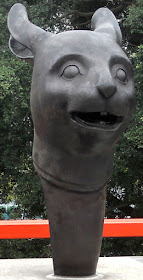Fung Ying Seen Koon is a Taoist temple complex on the hillside a short walk to the south of Fanling railway station. The buildings are modern, so there is little of historical interest here, but my cousin from the UK is staying with us at the moment, and there is plenty to see here, so I had no hesitation in placing it on his itinerary.
Of course, I had looked around the complex before, but I don’t recall seeing sculptures of the twelve animals that comprise the Chinese zodiac:
Most people will already know that unlike the Western zodiac, which is based on the motion of the sun and the planets, Chinese astrology is based on a repeating sequence of animals, each of which holds sway for a year. The changeover from one animal year to the next takes place on the second new moon following the winter solstice, the sequence being left to right in the above photos.
If you look closely at the photographs, you will see that each animal is identified in both Chinese and English. And if you’ve read any of my previous New Year reports, you will know that I consider this identification to often be incorrect. For example, this coming Tuesday marks the start of the year of the pig, yet the animal here is labelled a ‘boar’:
Am I being overly imaginative here, or does this ‘boar’ look surprisingly feminine for a male of the species?
Other examples of inappropriate sex-specific usage include the year of the chicken being mistakenly labelled ‘the year of the rooster’ (it’s identified here as a ‘cock’), and I’ve seen the year of the sheep described as ‘the year of the ram’. Yet none of the zodiac animals should be identified by such sex-specific names!
However, there are a couple of animals where some confusion is probably unavoidable. The most obvious is the sheep:
I have seen sheep with horns like this, but to me this looks more like a goat. And this is where the confusion arises, because Chinese does not distinguish between sheep and goats. The same word (yeung) is used for both.
I’ve always wondered how one particular animal made it onto the list: the rabbit:
Actually, this sculpture is labelled ‘hare’, which I’d not heard of previously. but here’s the rub: as far as I’m aware, neither hares nor rabbits are indigenous to China, which is the only plausible reason for thinking that the words ‘hare’ and ‘rabbit’ are somehow interchangeable.
The question of the eligibility of hares/rabbits to be included in the twelve begs an important question: how were the twelve animals chosen in the first place? And who decided? To my mind, the most important omission is the bear, but lions and elephants are also strong candidates. Even though neither is native to China, both play important roles in Chinese culture. And there are no birds in the twelve. Why?
Finally, I’ve included images of two sculptures that to my eyes don’t look even remotely like the animals they are supposed to represent:
I don’t propose to identify them. See if you can.







Interesting and timely story, HAPPY the Year of the Pig
ReplyDeleteLungma ching san!
Delete